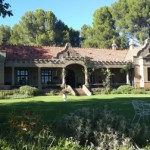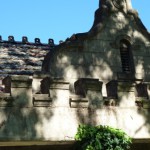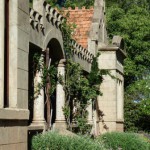I haul myself out of bed at 06:00 and, eyes still heavy with sleep, weave about the passage toward the bathroom (which, for me, is not en suite) for that arduous (but very necessary) daily ritual of showering and hair-washing. Conville’s plumbing, fittings and fixtures (right down to those funky bell doodads next to the main bed to summon ladies’ maids, à la Downton Abbey!) may be in need of some maintenance, but the whole place has a cosy yet intriguing feel about it, as though its rooms are begging to be explored. To me, a night here could be described as a quintessential stay at grandma’s: wooden floors, high brass beds, interesting antique furniture, piles of books, patterned wallpaper, and old paintings and photographs lining the walls.
There is, however, plenty of hot water on tap, and it is only after a thorough drenching and a cup of coffee that I feel capable of walking without the support of a wall or window sill.
History over Breakfast
Breakfast is at the long table in the rather grand dining room, with another guest couple who are passing through on their way to Sandstone Estates, Fouriesburg and then onto the Kruger National Park.
“Is that Scottish?” asks the lady, on hearing my mother’s accent. I smile and incline my head toward my mother, “Yes, that is Scottish, and that,” now indicating my father, “is South African!” Over yoghurt, cereal and fruit juice, we learn that the original owner of Conville was Scottish. Linda, our amiable hostess, and her husband Anthony, now own and run the farm, but it was Anthony’s grandfather who started it all and built the house for his young bride. Anthony appears, right on cue, and, while we tuck into our fried eggs, bacon, tomato and toast, he recounts some of Conville’s history, including his grandfather’s engineering background, involvement in an irrigation scheme on the Orange River and interactions with Sir Herbert Baker. It was Grandfather Gerrand’s early childhood in a Scottish castle together with the architectural skill of Herbert Baker which resulted in the design of this magnificent home, the construction of which was completed in 1908.
Linda asks what we’re doing in the area, and we explain that we’re hunting for relatives. Dead ones. We recount yesterday’s traumatic experience of searching for Aunt Minnie’s grave in the old cemetery, and Linda nods sympathetically. “We’re constantly fighting with the municipality about it,” she says. “But you should speak to Madeleine at the Aliwal Museum…” We need to track down Mr Wessels before we leave and still get to Grahamstown today, but have a day trip planned to Aliwal North from Burgersdorp later in our itinerary. Linda helpfully takes down details of the family we’re looking for to pass onto Madeleine before our return. Then she leaves the room briefly and returns flicking through a copy of Driehonderd Jaar Nasiebou – Stamouers Van Die Afrikanervolk by Dr D.F. du T. Malherbe . “There are no Wessons,” she says, handing the book to me. I’m almost twitching with anticipation as I quickly search for other surnames in our tree: Becker, Bolton, Meyer, Nelson – all have entries, but I don’t recognise any of the other details. I make notes regardless. Perhaps they’ll come in handy someday…
It only takes us a few minutes to pack our overnight bags back into the car, and then we’re bidding our gracious host and hostess farewell and heading back into town.
A Human Whirlwind
We pull up outside Community Services, just as an official-looking gentleman strides out of the office. I’m not about to let history repeat itself, so I launch myself out of the car and accost him: “Excuse me, Sir. Are you Mr Wessels?” To his credit, if he was surprised by my “attack”, he didn’t show it. A thick Afrikaans accent responds, “No, I’m Blackie Swart. Are you looking for Uri ? Can I help?” I explain that we’re looking for the grave of a relative, and he says, “Ah, no – you will need to speak to Uri, then,” and leads us back into the office building. “Where is Uri?” Mr Swart asks the man who is behind the bars of reception today. “He’s in a meeting,” comes the response. My shoulders start to droop with disappointment already, but we explain that we will be back in town the following week. Mr Swart recommends we make an appointment to see Mr Wessels then, and also suggests we speak to Madeleine Joubert at the museum. We confirm that we already have her in our sights. I’m exchanging details with Mr Receptionist when he suddenly says, “Just hold on. Just hold on. I think the meeting’s finished,” and disappears down a passage to my right. A few seconds later, he pops his head around the corner at the end of the passage and beckons to me. We thank Mr Swart for his help and quickly follow Mr Receptionist, who leads us to a tiny office, indicating that the occupant is Mr Wessels.
Mr Wessels, who is having a very loud, demonstrative exchange with a colleague, ushers us in with a “Kom in! Kom in!” before flinging a pile of papers into an in-tray, still muttering as his co-worker leaves the room. “Sit,” he says and I sit, as someone thoughtfully brings in a chair for my mother. Once again, we explain ourselves and, to my surprise, Mr Wessels picks up a note on his desk with the details we had given the receptionist yesterday. “O, ja – hierdie een,” and he jumps up, dashes to a steel cabinet which seems to be bursting at the seams, flings open the door, burrows around and emerges with a printout which he triumphantly drops on the corner of his desk and furiously starts paging through. “Wesson… Wesson… Wesson… Hier’s sy!” It is an alphabetical list of graves in the old cemetery and, sure enough, there is Aunt Minnie’s name. Mr Wessels scribbles the grave number on a piece of paper: 419009. Apparently, this means plot 4, row 19 and grave 9. He grabs his keys and says he’ll show us the grave. In the same breath, he puts his keys down again and spins round to rummage in the embankments of paper that have built up around his desk, mumbling something about “my ander boek”. Then he finds it and holds it aloft – an A4 exercise book. Snatching up his keys once more, he heads out the office at breakneck speed. The whole meeting has probably taken less than five minutes. Outside, we discover that my father has vanished, doubtless to buy a newspaper. We phone him to let him know that Mr Wessels is going to show us the grave, when Mr Wessels gets a phonecall. Apparently, someone has been digging somewhere and unearthed what appear to be human bones which apparently makes it Mr Wessels’ problem. Completely unphased, he’s not to be thrown off his current mission, but is clearly in a massive hurry, so we decide that I will drive to the cemetery with him while my mother waits for my Dad to return.
Mr Wessels is talking non-stop as his bakkie bounces obediently over and through the potholes which he barely seems to notice. As he careers around the left hand bend toward the graves, I say a quick prayer of gratitude for my seatbelt, without which I may have been flung straight out the drivers’ side window. He pulls to a stop at the same dejected-looking stone pillars we had seen the day before. It’s almost as if they themselves are somehow ashamed of the state of this that they are presiding over. Mr Wessels is out of the vehicle almost before I’ve managed to undo that seatbelt. He marches down the overgrown pathway in his boots, still talking ceaselessly, as I trot gingerly behind in my billowing skirt and flip-flops, camera swinging from my arm. He comes to an abrupt halt opposite a round, black sign with a large number 1 painted on it in white and points out a similar sign across the pathway with a large number 3 on it, before confirming with me in an easy English-Afrikaans mix that we’re looking for plot 4. I reply in the affirmative, and he continues talking at high speed (as much to himself as to me), deducing that plot 4 must be off to our left. And then he shoots off again, exercise book now open, ploughing through the knee-high grass, while I try to keep up and avoid broken beer bottles at the same time. He’s counting now, the row numbers in the plot, which, curiously, start at 9. How he manages to make any sense of the seemingly haphazard arrangement of overgrown graves, I’ll never know, but then I hear him say “neentien” and see him bolt off into the undergrowth on the right. He’s counting again, this time from 1. He squeezes between a large grave and a bright green shrub, before clambering over the corner of another grave and finally pausing to ask me who we’re looking for again. I remind him of the surname and he starts reading the graves: “Thomas?” “Nee,” I say, and he steps into the next row, muttering that perhaps it is one of the several broken graves in the vicinity, or one of those whose headstone has fallen, facedown into the dirt. I start losing hope – again. What are the chances that Great Great Aunt Minnie’s grave is still intact in all this mess?












